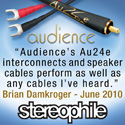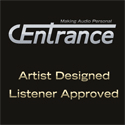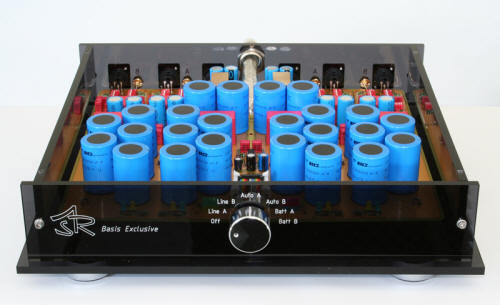|
|
You are reading the older HTML site
Positive Feedback ISSUE 61
monk-audio Phono Preamplifier as reviewed by Marshall Nack
Now here's an unusual product: the new MONK-AUDIO phono preamp from Germany. It is a small, black utility chassis only 8.6" W x 3.1" H x 12.2" D (220x80x310mm), weighing just 6.5lbs (3kg). But the front panel on that undersized box looks like a mixing board.
There are knobs for everything:
How's that for options? And all adjustments are made from outside the chassis. Suffice to say, the website proclaims universal adjustability was the aim. In addition, it is designed with conventional all-discrete circuitry and custom-made, high-quality MC step-up transformers. The manual is surprisingly comprehensive and has lots of useful info. Did you know there are technical reasons why selecting “mono” mode optimizes playback of mono LPs—in mono mode, “most of the inversely phased noise components mutually cancel each other…” Swapping among these EQ curves makes quite a difference. Do you think an MSRP of $3000 is asking too much for all this? (Ha, ha.) Functionality aside, it happens to be a top-notch performer at this price. I analyzed its performance and, try as I might, could not come up with any vices. This was unsettling because gear at this price level ALWAYS has issues. Plug the solid-state Monk in and you'll hear something that only hints at transistors. Perhaps that's because of the MC step-up transformers inside. (I always find transformers have this effect of reducing the solid-state signature.) The Monk's frequency response is even and it throws a soundstage that I would describe as holistic. Image borders tend to bleed into each other and it has a little more reverb than it should. But most everything you need to hear is there—no omissions—and it treads lightly; there's nothing to suggest a heavy footprint.
ASR Basis Exclusive (2008 model) Compared to my reference ASR Basis Exclusive, it is less resolving, dynamic and refined. I'd estimate it offers about 80% of the ASR. (My ASR is the 2008 version; current 2010 version Basis Exclusive's have a $9650 MSRP. I also use a K-S power cord, $1800/meter.) That means it competes with units in the $6K-7K area. It's worth checking out if you're shopping in this price range. Acoustic Systems International Footers However, the Monk's case becomes a lot more compelling with the addition of a set of Acoustic Systems International Top Line footers. (MSRP $750/set of three. Acoustic Systems International and MONK-AUDIO are both imported by Avatar Acoustics.)
ASI footers Slipping a trio of these footers under the Monk is like spending an additional couple of thousand dollars for a more expensive, tubed phono preamp. The solid-state signature becomes virtually undetectable. Impressions One sunny Saturday afternoon, I had Lynn and her oboe instructor sit down for a listen. For our first comparative selection I used the heavyweight, 1986 Chesky Records reissue of the Sibelius Symphony No. 2, with Sir John Barbirolli conducting the Royal Philharmonic (Chesky CR3). First we listened with my ASR Basis Exclusive in line.
It sounded very good, especially as the front-end was the Dr. Feickert Firebird turntable. Barbirolli builds up a lot of momentum and tension, so you're sitting on the edge of your seat. We were sucked in by the interpretation. We had a few sonic quibbles: this reissue has an edgy quality and the strings were a little wiry. When we swapped over to the Monk with the ASI footers in place, the first thing we noticed was how clear the stage became—those bleeding borders firmed up. Plus the timbral colors increased. The oboes, in particular, sounded less blunt than they did with the ASR. Both micro and macro dynamics improved. We all agreed the Sibelius was decidedly more listenable through the Monk than the ASR.
Next I put Louis Armstrong & Duke Ellington, a fine early Original Master Recording, on the platter (MFSL-2-155). Through the Monk, bass was powerful and slightly boomy and the Duke's piano had a peculiar, old-timey tinkly sound that nagged a bit. Nevertheless, the performance was compelling. We swapped to the ASR and, wouldn't you know it, the bass calmed down and acquired more overtones. Meanwhile, the piano sound opened up and lost some of that honky-tonk quality. We all agreed the MOFI recording was decidedly more listenable through the ASR. Conclusions So, what can we conclude from all this? Sometimes things are not straightforward. I think, depending on the LP and how your system is voiced, you're equally likely to prefer either phono stage. The point is that the Monk was not out of place in my reference system where all the other components cost at least three times its price (excepting the Modwright Sony SCD5400 SACD player). The ASR is honest, but it can be resolute. Given the way my system is voiced right now, it could stand to loosen up and become a tad more forgiving to accommodate the ASR. Maybe I'll try putting those ASI footers under the ASR. But this may be just your cup of tea. If I owned the Monk, I would definitely get the ASI footers for the acoustic boost they provide. In my system the Monk benefited from AC conditioning, with further improvements in resolution and dynamics. How to Get the Most from the Monk AC plug polarity is critical. The Monk's two-prong power plug will fit into a 3-prong receptacle in either direction, but one direction will sound much better. The importer has placed a black dot where the ground pin should be as a guide to correctly orienting the plug. Use this to orient the plug.
Try experimenting with power conditioning. The Monk's sound will change noticeably. One of the most popular tweaks in all the land is RCA Covers for unused single-ended inputs/outputs. I used the #1 input for the phono cable and covered the other two inputs. BTW, I also do this for all other components. I recently developed a three-tier component classification scheme. Components costing up to $5K I arbitrarily assigned Entry Level. The Mid Level ranges up to $10K. The Monk is the immediate exception that pushes beyond its MSRP into Level Two. With the addition of the ASI footers, it settles in the center of that category. It is one of the best buys at its price point. Marshall Nack
Monk Audio phono preamplifier
ASI Top Line Footers Manufacturer
Monk-Audio Distributor Information
Avatar Acoustics
|









